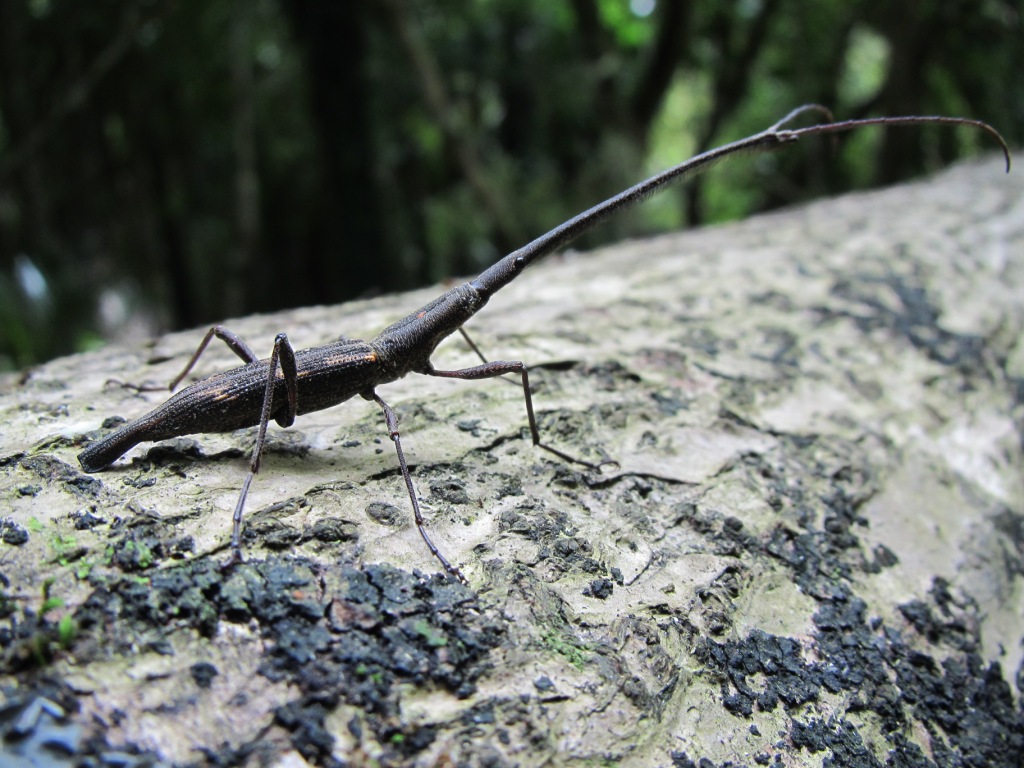Our group works on a wide range of topics in the field of behavioural ecology and conservation of invertebrates. We typically work with non-model organisms, including New Zealand giraffe weevils, fishing spiders and harvestmen – but the astounding diversity and beauty of Aotearoa New Zealand’s invertebrate fauna makes it easy to be distracted by new potential study species.
Our main research themes are:
Evolution of Exaggerated Traits
We are intrigued by the diversity of exaggerated traits displayed by males across the animal kingdom, especially those used as weapons. We explore the role of sexual selection in driving the evolution of weaponry using an integrated approach that combines morphology, ecology, behaviour and physiology. Current projects include comparative approaches to understanding weapon evolution and allometry in brentine weevils and long-legged harvestmen, and single-species projects focussing in on evolutionary oddities such as the New Zealand giraffe weevil and the ribbonwood fungus weevil.


Left: A handful of brentine weevils showing remarkable diversity in morphology & male trait exaggeration. Right: Foresteropsalis pureora, a long-legged harvestmen found in Aotearoa New Zealand’s forests, showing off his exaggerated chelicerae
Interaction Between Pre- and Post-copulatory Selection
Weapons can help male animals to gain mating opportunities by winning fights for females, but getting to mate is only part of what determines reproductive success. When females mate multiple times, male sperm must compete to fertilise her eggs. We know little about the relative importance of sexual selection operating before (pre-copulatory) and after (post-copulatory) mating, and how these two modes of sexual selection interact to maintain variation in reproductive success among males. In particular, few studies have quantified sexual selection among wild populations, despite this being crucial for understanding how mating systems evolve. Using classic field observations, molecular parentage analysis and social network theory we are investigating the interaction between pre- and post-copulatory traits in the New Zealand giraffe weevil, the males of which bear an enormously elongated rostrum used as a weapon.
Evolution of Monogyny & Extreme Male Mating Behaviours
Animal mating systems are highly diverse and understanding the evolutionary pathways that lead towards different mating systems remains an intriguing research avenue. In collaboration with Eileen Hebets, Matjaž Kuntner, and Cor Vink, we are exploring the evolutionary route to monogyny, where males mate with a single female in their lifetime. Dolomedes spiders (often called fishing, water, or nursery web spiders) provide a fantastic model to use in a comparative systems approach, because species vary dramatically in their mating behaviour, morphology and ecology. Aotearoa New Zealand is home to four endemic Dolomedes spiders, including the threatened Rangatira spider restricted to several predator-free islands in the Chatham Island archipelago. We are currently describing the mating systems, ecology and morphology of these species to contribute to the global comparative study.
Invertebrate Conservation
Invertebrates comprise the majority of biodiversity on earth and are critical to ecosystem function. We contribute to the conservation of invertebrates through our passion for understanding a species natural history, our field-based approach which focusses on wild populations, and our outreach activities. We acknowledge our privilege of being located in the beautiful Waikato, home to many endemic Aotearoa New Zealand invertebrates. We welcome collaborations with iwi, community groups, councils and other stakeholders interested in undertaking invertebrate conservation research.
Check out our roadmap paper on the conservation and recovery of insects.




Pingback: Horseshoe crabbing in Singapore | Chrissie Painting
Pingback: Trip to Southland, NZ – Erin Powell